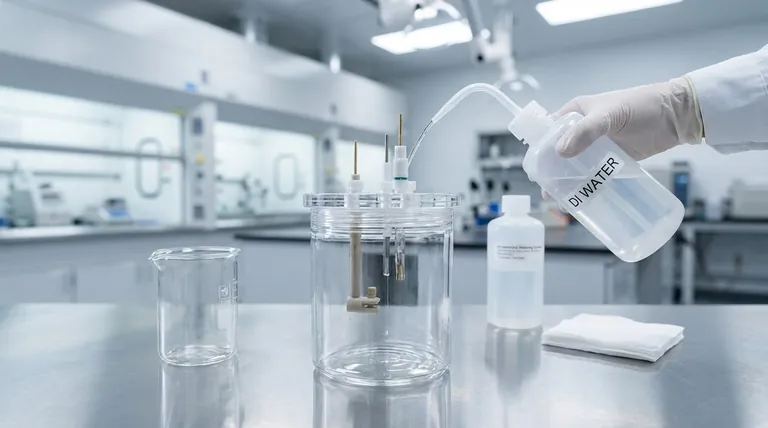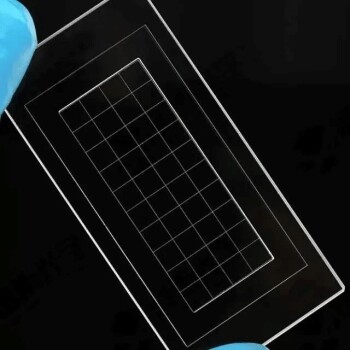To prevent experimental contamination in an acrylic electrolytic cell, you must implement a systematic protocol that includes meticulous pre-use cleaning, careful handling during the experiment, and control of the surrounding environment. This process begins with a thorough cleaning using an appropriate solvent and distilled water, followed by careful filling of the electrolyte and maintaining a dust-free workspace to ensure the purity of your reaction.
The key to preventing contamination is not a single action, but a comprehensive approach. You must treat the entire experimental process—from initial cell inspection to final data recording—as a controlled system designed to protect the purity of your electrolyte.

The Foundation: Pre-Experiment Preparation
Ensuring the integrity of your results starts long before you connect a power supply. A pristine cell is the bedrock of a successful experiment.
Initial Physical Inspection
Before any cleaning, carefully inspect the acrylic cell body. Look for any cracks, crazing, or damage, especially around seals and joints. A compromised cell can leak, introducing contaminants from the outside or leading to a loss of your carefully prepared electrolyte.
The Critical Cleaning Protocol
Residues from manufacturing or previous experiments are a primary source of contamination. First, wash the cell with a suitable solvent known to be compatible with acrylic to remove grease and organic impurities. Follow this with a thorough rinse using high-purity distilled or deionized water, and allow the cell to air dry completely in a dust-free area.
Preparing the Electrolyte
Contamination can also be internal. Prepare your electrolyte according to your specific experimental needs. This may include pre-treatments such as deoxygenation to remove dissolved oxygen, which can interfere with certain electrochemical reactions.
Best Practices During Operation
Once the experiment is underway, your focus shifts to preventing airborne and handling-related contaminants from entering the system.
Maintaining a Clean Workspace
Your immediate environment is a significant factor. Avoid performing any operations that generate dust, aerosols, or other pollutants in the vicinity of your setup. A clean, controlled lab space is your first line of defense against airborne particles.
Careful Electrolyte Handling
When filling the cell, pour the electrolyte slowly and carefully. To prevent splashing, which can introduce contaminants, fill the cell to a maximum of 80% of its total volume. A steady hand is crucial at this stage.
Monitoring and Sealing
After connecting the power supply, monitor the system for stability. More importantly, keep the cell covered or sealed as much as your experiment allows. This simple step creates a physical barrier against dust and other particles settling into your solution over time.
Understanding Material-Specific Trade-offs
Using an acrylic cell comes with specific considerations that differ from traditional glass cells. Understanding these is vital for preventing material-induced contamination.
Chemical Compatibility
Acrylic is not universally resistant to all chemicals, especially certain organic solvents. Using an incompatible cleaning solvent can cause the acrylic to craze or leach plasticizers into your electrolyte, creating a significant source of contamination. Always verify solvent compatibility before cleaning.
Physical Durability
While acrylic is more shatter-resistant than glass, it is also much softer and scratches easily. Scratches not only impede optical clarity but can also trap trace amounts of chemicals from previous experiments. This residue can be very difficult to remove and can leach into subsequent experiments, compromising your results.
A Protocol for Pristine Results
Your specific approach should be tailored to the sensitivity of your experiment.
- If your primary focus is high-precision trace analysis: Your cleaning protocol must be exhaustive, potentially involving multiple solvent rinses followed by high-purity deionized water.
- If your primary focus is repeatable general electrochemistry: Consistency is key. Use the same validated cleaning and handling protocol for every experiment to ensure your results are comparable.
- If your primary focus is long-term cell integrity: Pay close attention to material compatibility. Use only acrylic-safe solvents and handle the cell carefully to avoid scratches that can harbor future contaminants.
Ultimately, meticulous preparation and consistent, careful handling are the most effective strategies for guaranteeing the purity of your experiment and the reliability of your data.
Summary Table:
| Contamination Source | Prevention Method |
|---|---|
| Surface Residues | Clean with compatible solvent, rinse with high-purity distilled/deionized water. |
| Airborne Particles | Maintain a dust-free workspace; keep cell covered/sealed during operation. |
| Material Leaching | Verify chemical compatibility of solvents/electrolytes with acrylic. |
| Physical Damage | Inspect cell for cracks/scratches; handle carefully to avoid trapping residues. |
| Electrolyte Impurities | Prepare electrolyte with pre-treatments (e.g., deoxygenation) as needed. |
Achieve Uncompromised Purity in Your Electrochemical Experiments
Preventing contamination is critical for reliable data. KINTEK specializes in high-quality lab equipment and consumables designed to support your most demanding protocols. Whether you need durable, chemically compatible electrolytic cells or high-purity solvents, our products help you maintain the integrity of your research.
Let us help you eliminate experimental variables. Contact our experts today to discuss your specific laboratory needs and ensure your results are never compromised by contamination.
Visual Guide

Related Products
- Electrolytic Electrochemical Cell with Five-Port
- H-Type Double-Layer Optical Electrolytic Electrochemical Cell with Water Bath
- Double Layer Five-Port Water Bath Electrolytic Electrochemical Cell
- Electrolytic Electrochemical Cell for Coating Evaluation
- Customizable PEM Electrolysis Cells for Diverse Research Applications
People Also Ask
- How can leaks be prevented when using a five-port water bath electrolytic cell? Ensure a Reliable and Safe Electrochemical Setup
- What is the proper way to handle a five-port water bath electrolytic cell? Ensure Accurate and Safe Electrochemical Experiments
- What material is the five-port water bath electrolytic cell made of? High Borosilicate Glass & PTFE Explained
- How should the five-port water bath electrolytic cell be operated during an experiment? Master Precise Control for Reliable Results
- What are the standard components of the five-port water bath electrolytic cell? Master the Precision Instrument for Electrochemical Analysis



















